Jewish Historical Fiction for Older Readers: The Holocaust (Page 5) |
If you wish to purchase any of these books, click on either the title or the book cover to be directed to Amazon.com. As a warning, I have put up pictures of the book covers to give you somewhat an idea of the style of each book (I know, I know. "Don't judge a book by its cover") so the pages may load slowly, depending on the speed of your internet connection.
If this page came up without frames, Click here to see the complete website
For biographies of individuals associated with the Holocaust (Anne Frank,
Simon Wiesenthal, etc.), go to the
Biographies
For nonfiction Holocaustbooks, go to the
Holocaust History Page
For Holocaust books for younger readers, go to the Children's History Page
Other Pages of Interest:
Holocaust Historical Fiction Books For Middle School and Young Adult Readers ...
(Page 1)
(Page 2)
(Page 3)
(Page 4)
(Page 5)
(Page 6)
Holocaust History Books For Middle School and Young Adult Readers (Nonfiction)...
(Page 1)
(Page 2)
(Page 3)
(Page 4)
(Page 5)
(Page 6)
Middle School and YA Books ...
Bar Mitzvah Books |
Jewish Fiction |
Historical Fiction |
Torah Study |
Prayer and Jewish Life Books |
Jewish Holidays |
Jewish Biographies |
Jewish History Books |
Holocaust Books for Teens |
Israel Books
Jewish Historical Fiction for Middle School and YA Readers...
Biblical Era |
Middle Ages, Renaissance, and the Spanish Inquisition |
Immigration & The American Experience |
European History |
Holocaust
(Page 1)
(Page 2)
(Page 3)
(Page 4)
(Page 5)
(Page 6) |
Israel
Jewish History Books for Middle School and Young Adult Readers ...
General Jewish History & Nonfiction |
Biblical Era |
European History (Excluding the Holocaust) |
Immigration & The American Experience |
Holocaust |
Israel
Easy Reader and Picture Books ...
Jewish Children's Books (General) |
Jewish Board Books |
Biblical Stories for Children |
Jewish Holiday Books |
Jewish Family Cookbooks |
Folktales and Talmudic Stories for Children |
Jewish Life Books (Mitzvot, Keeping Kosher, etc.) |
Jewish Life Cycle Books |
Family Haggadahs |
Children's Prayerbooks |
Introductory Hebrew Books |
Jewish History and Historical Fiction Picture Books |
Israel Books
And More ...
Jewish Books for Children |
Bar Mitzvah Books |
Jewish Parenting Books |
Hanukkah Books |
Jewish Music for Children |
Jewish Videos |
Jewish Toys and Gifts |
Jewish Gift Baskets and Gourmet Food |
Jewish Jewelry |
Amazon.com Coupons, Promotions, and Sales
For biographies of individuals associated with the Holocaust (Anne Frank,
Simon Wiesenthal, etc.), go to the
Biographies
For nonfiction Holocaustbooks, go to the
Holocaust History Page
For Holocaust books for younger readers, go to the Children's History Page
Other Pages of Interest:
Holocaust Historical Fiction Books For Middle School and Young Adult Readers ...
(Page 1)
(Page 2)
(Page 3)
(Page 4)
(Page 5)
(Page 6)
Holocaust History Books For Middle School and Young Adult Readers (Nonfiction)...
(Page 1)
(Page 2)
(Page 3)
(Page 4)
(Page 5)
(Page 6)
Middle School and YA Books ...
Bar Mitzvah Books |
Jewish Fiction |
Historical Fiction |
Torah Study |
Prayer and Jewish Life Books |
Jewish Holidays |
Jewish Biographies |
Jewish History Books |
Holocaust Books for Teens |
Israel Books
Jewish Historical Fiction for Middle School and YA Readers...
Biblical Era |
Middle Ages, Renaissance, and the Spanish Inquisition |
Immigration & The American Experience |
European History |
Holocaust
(Page 1)
(Page 2)
(Page 3)
(Page 4)
(Page 5)
(Page 6) |
Israel
Jewish History Books for Middle School and Young Adult Readers ...
General Jewish History & Nonfiction |
Biblical Era |
European History (Excluding the Holocaust) |
Immigration & The American Experience |
Holocaust |
Israel
Easy Reader and Picture Books ...
Jewish Children's Books (General) |
Jewish Board Books |
Biblical Stories for Children |
Jewish Holiday Books |
Jewish Family Cookbooks |
Folktales and Talmudic Stories for Children |
Jewish Life Books (Mitzvot, Keeping Kosher, etc.) |
Jewish Life Cycle Books |
Family Haggadahs |
Children's Prayerbooks |
Introductory Hebrew Books |
Jewish History and Historical Fiction Picture Books |
Israel Books
And More ...
Jewish Books for Children |
Bar Mitzvah Books |
Jewish Parenting Books |
Hanukkah Books |
Jewish Music for Children |
Jewish Videos |
Jewish Toys and Gifts |
Jewish Gift Baskets and Gourmet Food |
Jewish Jewelry |
Amazon.com Coupons, Promotions, and Sales
Other Pages of Interest:
Holocaust Historical Fiction Books For Middle School and Young Adult Readers ...
(Page 1)
(Page 2)
(Page 3)
(Page 4)
(Page 5)
(Page 6)
Holocaust History Books For Middle School and Young Adult Readers (Nonfiction)...
(Page 1)
(Page 2)
(Page 3)
(Page 4)
(Page 5)
(Page 6)
Middle School and YA Books ...
Bar Mitzvah Books |
Jewish Fiction |
Historical Fiction |
Torah Study |
Prayer and Jewish Life Books |
Jewish Holidays |
Jewish Biographies |
Jewish History Books |
Holocaust Books for Teens |
Israel Books
Jewish Historical Fiction for Middle School and YA Readers...
Biblical Era |
Middle Ages, Renaissance, and the Spanish Inquisition |
Immigration & The American Experience |
European History |
Holocaust
(Page 1)
(Page 2)
(Page 3)
(Page 4)
(Page 5)
(Page 6) |
Israel
Jewish History Books for Middle School and Young Adult Readers ...
General Jewish History & Nonfiction |
Biblical Era |
European History (Excluding the Holocaust) |
Immigration & The American Experience |
Holocaust |
Israel
Easy Reader and Picture Books ...
Jewish Children's Books (General) |
Jewish Board Books |
Biblical Stories for Children |
Jewish Holiday Books |
Jewish Family Cookbooks |
Folktales and Talmudic Stories for Children |
Jewish Life Books (Mitzvot, Keeping Kosher, etc.) |
Jewish Life Cycle Books |
Family Haggadahs |
Children's Prayerbooks |
Introductory Hebrew Books |
Jewish History and Historical Fiction Picture Books |
Israel Books
And More ...
Jewish Books for Children |
Bar Mitzvah Books |
Jewish Parenting Books |
Hanukkah Books |
Jewish Music for Children |
Jewish Videos |
Jewish Toys and Gifts |
Jewish Gift Baskets and Gourmet Food |
Jewish Jewelry |
Amazon.com Coupons, Promotions, and Sales
Holocaust History Books For Middle School and Young Adult Readers (Nonfiction)... (Page 1) (Page 2) (Page 3) (Page 4) (Page 5) (Page 6)
Middle School and YA Books ... Bar Mitzvah Books | Jewish Fiction | Historical Fiction | Torah Study | Prayer and Jewish Life Books | Jewish Holidays | Jewish Biographies | Jewish History Books | Holocaust Books for Teens | Israel Books
Jewish Historical Fiction for Middle School and YA Readers... Biblical Era | Middle Ages, Renaissance, and the Spanish Inquisition | Immigration & The American Experience | European History | Holocaust (Page 1) (Page 2) (Page 3) (Page 4) (Page 5) (Page 6) | Israel
Jewish History Books for Middle School and Young Adult Readers ... General Jewish History & Nonfiction | Biblical Era | European History (Excluding the Holocaust) | Immigration & The American Experience | Holocaust | Israel
Easy Reader and Picture Books ... Jewish Children's Books (General) | Jewish Board Books | Biblical Stories for Children | Jewish Holiday Books | Jewish Family Cookbooks | Folktales and Talmudic Stories for Children | Jewish Life Books (Mitzvot, Keeping Kosher, etc.) | Jewish Life Cycle Books | Family Haggadahs | Children's Prayerbooks | Introductory Hebrew Books | Jewish History and Historical Fiction Picture Books | Israel Books
And More ... Jewish Books for Children | Bar Mitzvah Books | Jewish Parenting Books | Hanukkah Books | Jewish Music for Children | Jewish Videos | Jewish Toys and Gifts | Jewish Gift Baskets and Gourmet Food | Jewish Jewelry | Amazon.com Coupons, Promotions, and Sales
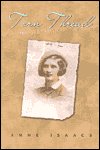 Torn Thread By Anne Isaacs |
The author of the uproarious tall tale Swamp Angel (1994) moves into a very different mode here in a grim Holocaust novel based on her mother-in-law's experience as a young teenage prisoner in a Nazi labor camp. The focus of Eva's story is always her bond with her fragile older sister, Rachel. They protect, even overprotect, each other, first in the Polish ghetto, and then for two years as prisoners in a Nazi labor camp in Czechoslovakia, where every day, every hour, is a struggle with hunger, disease, cold, and hard labor. Isaacs tells it without exploitation or sentimentality. She shows that there are Poles, and even some Jews, who help the Nazis and that many ordinary people are afraid to do anything or are just "uninterested." There is even one German camp officer who secretly does what he can to help the prisoners. The genocide horror is distanced because this is not a death camp, though Eva witnesses heartrending scenes of prisoners being marched to Auschwitz. Tension builds as the sisters, starving, sick, surrounded by filth, and checking each other's hair for lice, try to stay alive in the last months, one hour at time, until the Allies liberate the camp. As with the brother and sister in Anita Lobel's
No Pretty Pictures (Booklist's 1998 Top of the List winner for Youth Nonfiction) and in Schoschana Rabinovici's
Thanks to My Mother (the 1998 Batchelder Award winner), family love is a fact of survival.
|
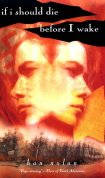 If I Should Die before I Wake By Han Nolan |
Nolan's first novel is ambitious indeed: she frames the story of teenage
Chana's survival in the Lodz ghetto and Auschwitz with a second story,
about a young neo-Nazi who--after a motorcycle accident from which her
vicious boyfriend escapes unscathed--is in the intensive care unit where
Chana is dying half a century later. Also near death, Hilary relives
Chana's ordeal and eventually recovers to carry on Chana's role as
Holocaust witness. There are some real strengths here: Chana's
experiences--losing her family, one by one; escaping Lodz with her
grandmother only to be jailed, tortured, identified as a Jew, and sent
to the concentration camp; brutal conditions, desperate survival
techniques, and alliances and betrayals among Jewish inmates; the
degradation of playing the violin for the Nazis in order to survive--are
evidently selected in order to depict a range of horrors; but they're
also graphically and tellingly portrayed. Hilary is less convincing: her
troubled past is too briefly sketched to make a firm basis for her almost
sensationalized fanaticism, while her change of heart doesn't develop; it
simply emerges full-blown. Still, juxtaposing the virulent paranoia of
present-day skinheads with their forebears' atrocities is a bold basis
for a novel; if some of the transitions here are a bit awkward, the book
as a whole is deeply felt and often compelling.
|
 Best Friends By Elisabeth Reuter |
Graphically highlights what happened in 1938, when the Nazi propaganda machine began incorporating anti-Semitic doctrines within the German school system. Two children, one Jewish and the other German, are best friends until the policy at school becomes “Jews cause all the problems in Germany!”
Excellent as an example of the terrible results of the Holocaust and good for generating a discussion about prejudice and war. The ending is very sad, so the book is probably most suitable for slightly older children. As Nazi propaganda and policies change attitudes in pre-World War II Germany, Judith and Lisa's friendship falters. Forbidden to see her friend, Lisa meets Judith secretly, until she declares that only she should be allowed to play with their favorite teddy bear since Judith is "`just a Jewish girl.'" Although she regrets this outburst, she is never able to apologize, since Judith and her family are taken away on Kristallnacht. |
 The Hunted By Peter Carter |
In the south of France in 1943, weary Italian troops are about to head home
after the Italian surrender. Among them is Corporal Vito Salvani, an amiable
giant of a man. However, things are not easy as the Italian troops try to
rescue the Jews in their sector from the approaching Germans. Circumstances
find Salvani walking toward the Italian border with a small Jewish boy,
Judah. Meanwhile, a maniacal member of the French police, a collaborator
named Palet, is after them because he believes the child possesses diamonds.
This is the tale of their journey and the people who help them along the
way. The plot develops rather well and is full of excitement. However, with
the exception of Salvani, character development is sacrificed. Salvani is a
true human being, with his concern for the child alternating with his
occasional desire to leave him behind and continue on home. Though the man
is not bright, he realizes his limitations; it is his strength and inherent
kindness that get him through. Other characters are strongly stereotyped,
especially Palet and the Germans with whom he works. They are completely
evil with no redeeming qualities. The story is good and, for the most part,
flows well. However, some chapters begin with a description of what was
happening to the Jews who didn't escape. Poignant early in the story,
especially with the use of names to make it more real, this diversion
becomes disruptive later on. The book is rather long, but it's an
interesting tale about a little-known aspect of the war.
This breathlessly paced historical novel is not a literary masterpiece, but it does an outstanding job of recreating the ambience of WW II France, measuring the chill efficiency of the Gestapo and assessing the ruthless fervor of other accomplices to the Holocaust. When the Italian forces withdraw from France following Italy's surrender in 1943, Vito Salvani, an Italian corporal, gets trapped behind enemy lines--along with Judah, a Jewish child he has promised to take to the safety of Italy. A few innocent missteps and unlucky encounters bring Salvani and his charge to the attention of a particularly single-minded inspector from the Vichy secret police, and a harrowing pursuit begins. Those who help Salvani and Judah are severely punished; several scenes of a Gestapo interrogation suggest the brutality and inexorability of the government's treatment of Jews and other so-called enemies ... Their story is believable and utterly gripping; the reader will leave this novel with some appreciation of the extraordinary good fortune and courage of people who successfully resisted the Nazi regime. |
 Journey to America: Aniela Kaminski's Story: A Voyage from Poland During WWII By Clare Pastore |
When Aniela's Jewish friends in Warsaw start disappearing, she flees to America with her father. But even though she loves her new homeland, Aniela longs for those she left behind.
Even as the shadow of war hangs over Europe in the summer of 1939, twelve-year-old Aniela Kaminski and her friends in Warsaw, Poland, try to continue on with the daily routine of their lives. But soon, everything changes in terrifying ways. Without warning, German planes strike. The terrified residents of the city are often forced to huddle in basements as bombs fall overhead. Although the Polish troops fight valiantly, they are defeated by the powerful German army. The Nazis that occupy the city kill anyone that disobeys their rules, and the war has created food shortages. Aniela's Jewish friend, Edith, is forced to flee Poland with her family. Aniela's widowed father fears for the safety of his daughter in an occupied country, and arranges for the two of them to travel to neutral Sweden, where they will board a ship bound for the United States. America is a wonderful place, but even there Aniela is not free of hardship and prejudice. Can Aniela overcome the obstacles she faces in order to achieve her dreams? Journey to America is a wonderful new series that I reccomend to all fans of the popular Dear America books. |
 Alan and Naomi By Myron Levoy |
Awards:
When Naomi, a refugee child from Nazi-occupied Paris who acts ‘crazy,’ moves into Alan Silverman’s building in 1940s New York, he does his best to avoid her. They slowly develop a deep and touching friendship.
|
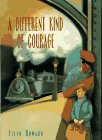 A Different Kind of Courage By Ellen Howard |
A real World War II rescue journey is the background for this novel about two children, Bertrand
and Zina, escaping from different parts of France in 1940 to safety in the U.S. They eventually
meet on a train hurtling them across Europe, and they help each other grope toward acceptance.
Howard captures with extraordinary power is the children's sense of abandonment at being sent
away by their parents, even to safety. Zina is so terrified and isolated that she stops speaking.
The families aren't idyllic to begin with, and the children's displacement gets mixed up with
feelings of jealousy, rejection, guilt (is it because I was bad?), anger, and sorrow. With fine
restraint, Howard takes us right into the child refugee's consciousness, and we recognize how
the separation from home may be as traumatic as the bombs of war.
|
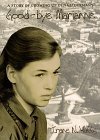 Good-Bye Marianne By Irene N. Watts |
"Dogs and Jews not admitted." Watts was one of the 10,000 Jewish children
who were sent from Nazi Europe to Britain in the Kindertransport rescue
operation in 1938; her moving autobiographical novel personalizes what it
was like to be a Jewish child in Berlin at the time. Marianne Kohn, 11, is
locked out of her Berlin school; synagogues and Jewish shops are looted and
burned; her father is in hiding; the streets are loud with violence and marching
Nazi youth. As the violence gets closer and Marianne must hole up in her
apartment, she fiercely resists her mother's decision to send her away. Olga
Drucker's Kindertransport (1992) and Dorith Sim's picture
book In
My Pocket (1997) tell of the children's leaving and their journey to foster homes. Here
the focus is on the racist persecution that drove parents to send their children
away to safety. The mother is idealized, but her heartbreaking letter to
Marianne ("One day you will understand why I had to let you go") is as
unforgettable as their anguished parting.
|
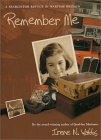 Remember Me By Irene N. Watts |
In this sequel to
Good-bye,
Marianne, Watts continues the story of a young Jewish child living
in Berlin in 1938. As the book opens, Marianne is on a train to London with
the first Kindertransport, a rescue operation for children that would
eventually remove approximately 9300 refugees from Germany, Austria, Poland,
and Czechoslovakia. Upon her arrival, the 11-year-old is situated in the
first of a series of foster homes that go from bad to worse. Initially
placed with a couple looking for a domestic, she is lonely and homesick. As
war threatens England, she is evacuated to Wales with a large group of
British children. Life doesn't get any easier in this small town: Marianne
is accused of spying, meets with a great deal of anti-Semitism, and is
billeted with a couple who view her as a replacement for their deceased
daughter. In the end, Marianne proves to be lucky; her mother arrives in
England, and she is one of the few children from this operation ever to
see a parent again. While Watts leans toward the melodramatic, with
Marianne facing horrific situations at every turn, the subject is an
important part of Holocaust history and would be useful if combined with
a nonfiction work, such as Anne Fox's Ten
Thousand Children
|
 Friends Forever By Miriam Chaikin |
As news of German victories and Nazi atrocities against the Jews comes over the radio, Molly faces important decisions as she and her Brooklyn friends prepare to enter junior high school.
|
 Sacred Shadows By Maxine Rose Schur |
"When I was told my father was dead, I ran away....I reached the pine grove, and there I flung myself down, hugged the damp earth, and waited."Against a pre-Hitler backdrop rarely viewed in young adult novels, Lena Katz suddenly learns that the Germany for which her father died is now considered part of Poland. She grows up torn between her desire to leave and her allegiance to her mother, who ignores thecountry's growing anti-Semitism. Then Janusz, a handsome young idealist, enters Lena's world and alters her life forever. Maxine Rose Schur's books include The Circlemaker (Dial), her first novel, which Publishers Weekly hailed as "atmospheric and suspenseful...maintaining an edge-of-the-seat tension until the very last words."
Lena Katz is a Jewish girl growing up in Germany in the period between the two world wars. After Poland reclaims the German province in which her family lives, anti-Semitic activity becomes more blatant. Lena's mother believes that things will get better and resists all attempts by her extended family to get her to move to Germany. Many of Lena's Jewish friends, including romantic interest Janusz, are attracted to the new Zionist movement, and Lena is caught in the middle of a difficult dilemma: remain with her war-widowed mother or flee to Palestine. The novel's suspenseful ending is rendered more powerful by the knowledge that most readers will bring to it: many Jews who did not leave Europe did not survive World War II. The book is most successful at making real the ways in which Lena's life is affected by racial hatred. For example, her mother's previously successful shoe store is unable to compete with stores owned by non-Jews after suppliers will no longer provide her with shoes and customers are too intimidated to shop there. Libraries may want to purchase this for its unique historical perspective. An afterword supplies factual details about the destruction Hitler wrought in Europe. Schur (When I Left My Village) draws on family history for this ominous tale of German and Polish Jews facing rising tides of anti-Semitism in the years before Hitler's rise. In the wake of her father's death at Verdun, young Lena Katz and her mother run a successful shoe store in Ledniezno, once a town in Germany, now part of a reconstituted Poland. Being both German and Jewish, they and their friends come under increasing attacks as the years go by--a time in which Heine's poems become attributed to "anonymous" in new editions of Lena's textbooks, newspaper and government antagonism toward Jewish businesses becomes more open, and local support for the Nazis grows. Lena's mother refuses to leave Poland, promising better times ahead and angrily rejecting the Zionism of Lena's heartthrob, Janusz. Spanning the years between 1917 to 1932, the plot is episodic and slow to develop; Lena's innocence in the face of all she sees and hears is artificially prolonged, while the ending, in which Lena at first refuses and then decides to accompany Janusz to Palestine, passes without even a parting scene with her mother. A brief afterword encapsulates the Holocaust and the foundation of Israel. The novel offers readers a moving glimpse of how public opinion set the stage for genocide, although that purpose occasionally engulfs the storyline and characters. |
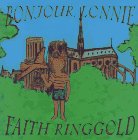 Bonjour, Lonnie By Faith Ringgold |
This unusual story involves Lonnie, the red-haired, green-eyed boy
introduced in Ringgold's Dinner
at Aunt Connie's House. He pursues an elusive "Love Bird" around
Paris until it leads him to a dreamlike place where he learns his
family's history and how he came to be orphaned. Lonnie meets his
African-American grandfather, who expatriated to Paris in the 1920s;
his French grandmother; his soldier father, who was killed in World
War II; and his Jewish mother, who died in the Holocaust. Lonnie is
told that he was smuggled to the U.S. by an African-American student.
Though he wants to stay with his family, they convince him to return
to the "real world," and the magical Love Bird transports him to his
adoptive parents. The Love Bird is a somewhat awkward device but it
helps bridge the fantasy and realism in the story. The artwork,
similar in style to that of Ringgold's earlier books, also incorporates
elements of fantasy and realism. The artist shows strong positive images
of whites and blacks together and makes children aware that both Jews
and African Americans have endured prejudice. However, because many
issues and historical references are touched upon but not fully
explained, youngsters may be left with many unanswered questions.
While not totally successful as a story, this unique book focuses
on aspects of history that are not commonly covered for this audience.
|